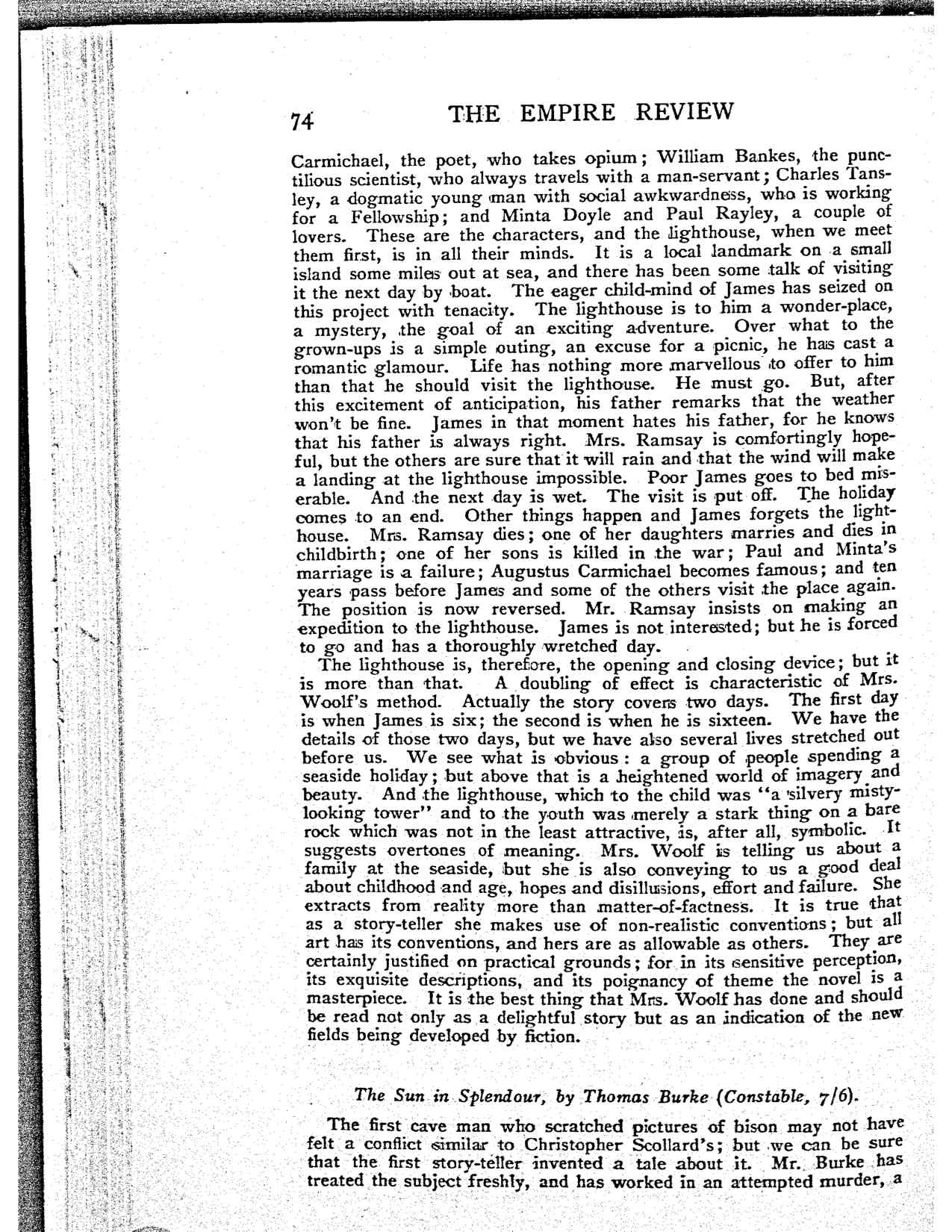
[next page]
Carmichael, the poet, who takes opium; William Bankes, the punctilious
scientist, who always travels with a man-servant; Charles Tansley,
a dogmatic young man with social awkwardness, who is working
for a Fellowship; and Minta Doyle and Paul Rayley, a couple of
lovers. These are the characters, and the lighthouse, when we meet
them first, is in all their minds. It is a local landmark on a small
island some miles out at sea, and there has been some talk of visiting
it the next day by boat. The eager child-mind of James has seized on
this project with tenacity. The lighthouse is to him a wonder-place,
a mystery, the goal of an exciting adventure. Over what to the
grown-ups is a simple outing, an excuse for a picnic, he has cast a
romantic glamour. Life has nothing more marvellous to offer to him
than that he should visit the lighthouse. He must go. But, after
this excitement of anticipation, his father remarks that the weather
won’t be fine. James in that moment hates his father, for he knows
that his father is always right. Mrs. Ramsay is comfortingly hopeful,
but the others are sure that it will rain and that the wind will make
a landing at the lighthouse impossible. Poor James goes to bed miserable.
And the next day is wet. The visit is put off. The holiday
comes to an end. Other things happen and James forgets the lighthouse.
Mrs. Ramsay dies; one of her daughters marries and dies in
childbirth; one of her sons is killed in the war; Paul and Minta’s
marriage is a failure; Augustus Carmichael becomes famous; and ten
years pass before James and some of the others visit the place again.
The position is now reversed. Mr. Ramsay insists on making an
expedition to the lighthouse. James is not interested; but he is forced
to go and has a thoroughly wretched day.
The lighthouse is, therefore, the opening and closing device; but it
is more than that. A doubling of effect is characteristic of Mrs.
Woolf’s method. Actually the story covers two days. The first day
is when James is six; the second is when he is sixteen. We have the
details of those two days, but we have also several lives stretched out
before us. We see what is obvious: a group of people spending a
seaside holiday; but above that is a heightened world of imagery and
beauty. And the lighthouse, which to the child was “a silvery misty-
looking tower” and to the youth was merely a stark thing on a bare
rock which was not in the least attractive, is, after all, symbolic. It
suggests overtones of meaning. Mrs. Woolf is telling us about a
family at the seaside, but she is also conveying to us a good deal
about childhood and age, hopes and disillusions, effort and failure. She
extracts from reality more than matter-of-factness. It is true that
as a story-teller she makes use of non-realistic conventions; but all
art has its conventions, and hers are as allowable as others. They are
certainly justified on practical grounds; for in its sensitive perception,
its exquisite descriptions, and its poignancy of theme the novel is a
masterpiece. It is the best thing that Mrs. Woolf has done and should
be read not only as a delightful story but as an indication of the new
fields being developed by fiction.






